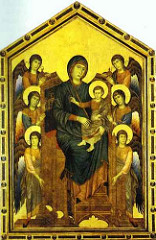
Trained Giotto (di Bondone).
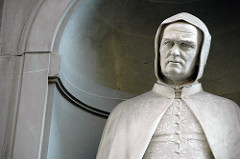
Sometimes called Father of Renaissance painting; he used perspective first; facial expressions reflect humanity and emotion.
First to experiment with Chiaroscuro (the study of light/dark) ;
frescos “The Ascension,” and “The funeral of St. Francis” were possibly his most famous. Trained under Cimabue in Byzantine style.
Characteristics: Rebirth of classical culture
Top 4 Breakthroughs, Oil on Streached Canvas; Perspective; Chiaroscuro (the use of light and shadow); Pyramid Configuration
Main Works/Artists: Ghiberti’s Doors, Brunelleschi, Donatello, Botticelli, Leonardo, Michelangelo, Raphael
Important Historical Events/Influences:
Gutenberg invents movable type (1447); Turks conquer Constantinople (1453); Columbus lands in New World (1492); Martin Luther starts Reformation (1517)

Renaissance Called “father of modern painting” Florentine painter; effectively use chiaroscure technique for greater sense of perspective; gave mathematical precision to the use of perspective; influential to other It. Ren. artists; painted the fresco of The Holy Trinity.
-Rome- they had a passion for classics, and systematically measured Roman ruins to copy the style and proportion. They revived elements like Rounded Arch, Concrete Construction, Domed Rotunda, Portico, barrel Vault, and columns
-Rules- Architects considered themselves scholars rather than simply builders; they based work on theories, as expressed in various treatises. Alberti formulated rules that were widely followed.
-Reason- Theories emphasized architecture’s rational basis, grounded in science, math, and engineering. Cool reason replaced the mystical approach of the middle ages.
-‘Rithmetic- Architects depended on arithmetic to produce beauty and harmony. A system of ideal proportions related parts of a building to each other in numerica ratios. Such as 2:1 ratio of a nave= twice as high as the width of a church. Layouts relied on geometric shapes, particularly the circle & square.
Famous Architects of Renaissance were Alberti, Brunelleschi Bramante and Palladio.
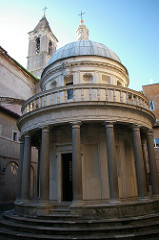
Built in Rome on the site where St. Peter was crucified. Tiny, but the perfect prototype of the domed central plan church. Expressed Renaissance ideals of order, simplicity, and harmonious proportions.

An architect who boldly combined roman classical and Gothic architecture. It illustrates the revival of Roman forms and Renaissance emphasis on symmetry and regularity.
Known as “father of modern engineering”
He used geometry as the basis for his designs, focusing on spheres and planes. He built the dome on the cathedral in Florence, starting in 1420. He also is given credit for being the first to understand and use perspective, although it was immediately used more clearly in sculpture and painting.
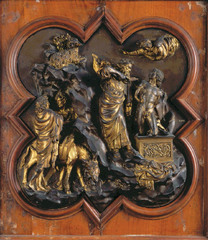
A Italian Renaissance sculptor and metal worker.
Florentine sculptor and goldsmith who taught both Donatello and Filippo Brunelleschi. He is best known for two pairs of bronze doors on the Florence Baptistery (associated with the Duomo, or Florentine Cathedral). He produced a single, low-relief panel to win a 1401 competition (defeating Brunelleschi) for the commission to design the 28 panels for the north doors. After that, he was given another commission to design ten panels for the east doors. This latter work, by far his most famous, was dubbed the “Gates of Paradise” by Michelangelo.

Wrote “Four Books on Architecture”
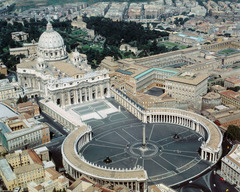
– architect – Michelangelo (built dome/decorations)
– on St. Peter’s tomb (buried in 67 CE) as a chapel
– ordered rebuilt by Constantine in 324CE
– restored by Pope John Paul II
– 1506CE – 1626CE
– Largest interior space of any Christian church (pope’s main church
-tallest dome in the world
-Corinthian columns

Donatello’s David (after the fight) c. 1425-1430, Early Renaissance (Goliath represents Milan)
Michelangelo’s David (before the fight) c.1501-1504, High Renaissance, (Goliath represents Rome/Medici power)
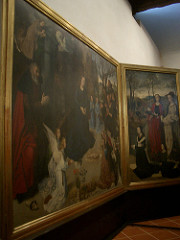
Flemish painter; along with Jan van Eyck, and Rogier van der Weyden, was one of the most important of the Early Netherlandish painters. Flanders -combines van Eyck’s naturalistic feel with van der Weyden’s use of dramatic emotion Portinari Altarpiece
Born at Ghent, he became a member of the painters’ guild of Ghent as a master in 1467.

A surrealist painter of the Netherlands who focused his works on symbolism, fantasy, confusion, death and the torments of Hell. Most famous work = “Death and the Miser” (1490)
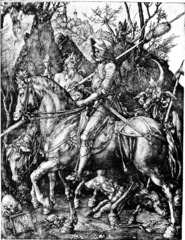


Born 1475 and died 1564
Architect, poet, and painter
used a lot of religious iconography
Work of Art
– took him two years to make it
-subtle but sturdy triangles and arches
– pain in mary’s face b/c her son is dead
– very detailed
– christ dead on his mothers lap
– carved in Carrara marble
– 1497-1499
– only work he ever signed
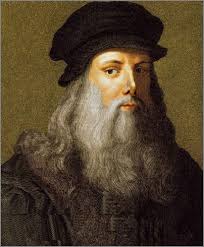
An Italian painter, sculptor, and architect of the fifteenth and sixteenth centuries. Among many achievements in a life of nearly ninety years, Michelangelo sculpted the David and several versions of the Pietà, painted the ceiling and rear wall of the Sistine Chapel, and served as one of the architects of Saint Peter’s Basilica, designing its famous dome. He is considered one of the greatest artists of all time.
The Last Judgement, 1534-1541, is painted on the altar wall of the Sistine Chapel. It depicts the second coming of Christ and shows souls of humans rising and descending to their fates. Vatican, Rome.

Characteristics: The Renaissance spreads north- ward to France, the Low Countries, Poland, Germany, and England
Main Works/Artists: Bellini, Giorgione, Titian, Dürer, Bruegel, Bosch, Jan van Eyck, Rogier van der Weyden
Council of Trent and Counter-Reformation (1545-1563); Copernicus proves the Earth revolves around the Sun (1543
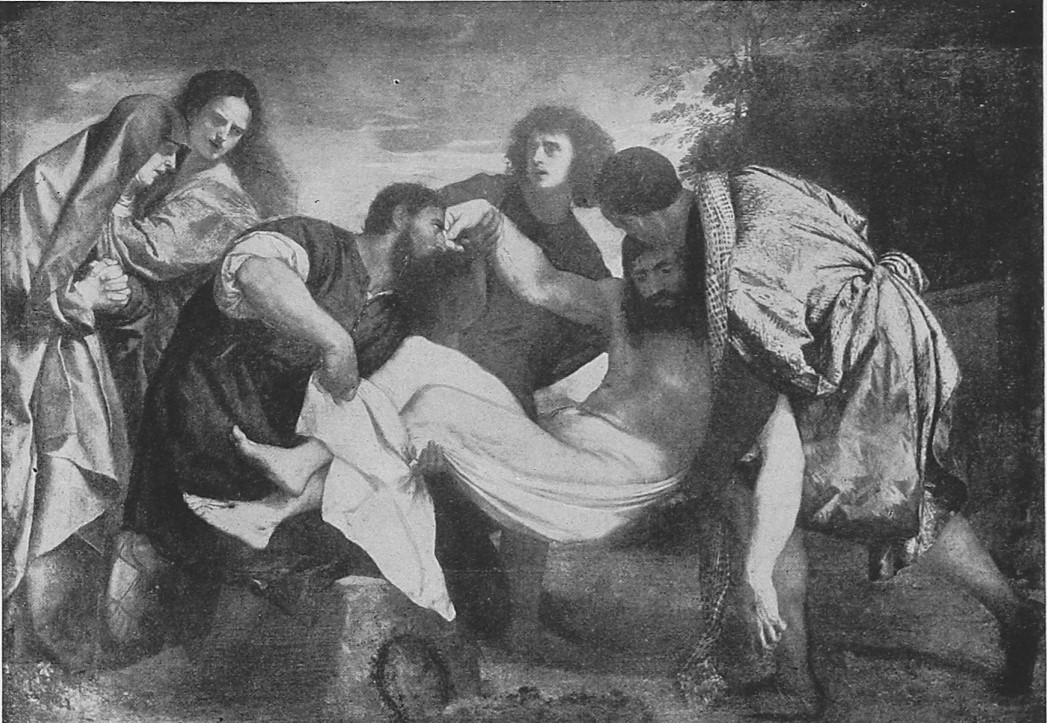
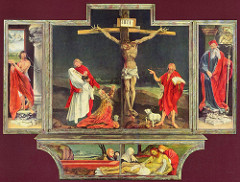
A German Renaissance painter of religious works, ignored Renaissance classicism, continued the expressive and intense style of late medieval Central European art into the 16th century, Isenheim Altarpiece
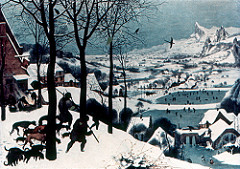
The Hunters in the Snow — also known as The Return of the Hunters — is a celebrated oil on wood painting by Pieter Bruegel. The work is one in a series of six works, five of which still survive, that depict different times of the year. , one of the most famous flemish artists, painted in the mid-1500s, loved the countryside/peasants and painted scenes with them; also used paintings as a means to criticize intolerance and cruelty

-Flemish (dutch) Renaissance painter
-the peasant painter, not b/c he was a peasant but because he found the carefree attitude of the Peasants to be refreshing next to the stifled “posing” of the upper classes.
-children’s games
-ou can always tell his work because it’s almost always busy with these detailed little people, rather than close-ups.
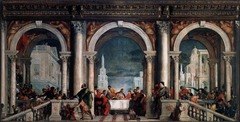

(Holbein was from Germany, and was a portraitist. He linked German and Italian painting styles. His most famous piece is The Ambassadors, a painting of two men with many gadgets, and a strange skull at the bottom.) He was commissioned by Henry VIII to provide portraits of the English king’s prospective brides (1497-1543)
Characteristics: Art that breaks the rules; artifice over nature. Mannerism makes itself known by elongated proportions, highly stylized poses, and lack of clear perspective.
Main Works/Artists: Tintoretto, El Greco, Pontormo, Bronzino, Cellini
Magellan circumnavigates the globe (1520-1522)
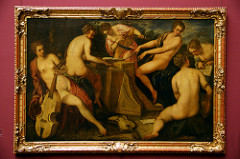
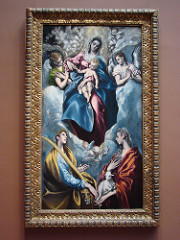

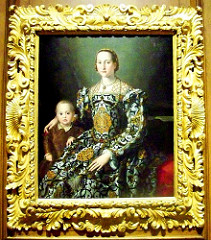
Place of Origin: Florence
Place of Art: Florence
Style Characteristics: Long necks, sloping shoulders
Innovations:
Major Works: Portrait of a Young Man, Eleanor of Toledo and Her Son Giovanni de Medici (shown)
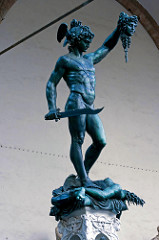
• Florence, Italy (he moved around a lot)
• The Cellini Salt Cellar, The Nymph of Fontainebleau, sculpture – Perseus with the head of Medusa (shown)
• Autobiography
• Gold Smith and sculptor who was certain of his own personal genius that he wrote about in his autobiography so that the whole world might appreciate it. Killed a man who criticized him (critic?) and got away with it
Baroque





